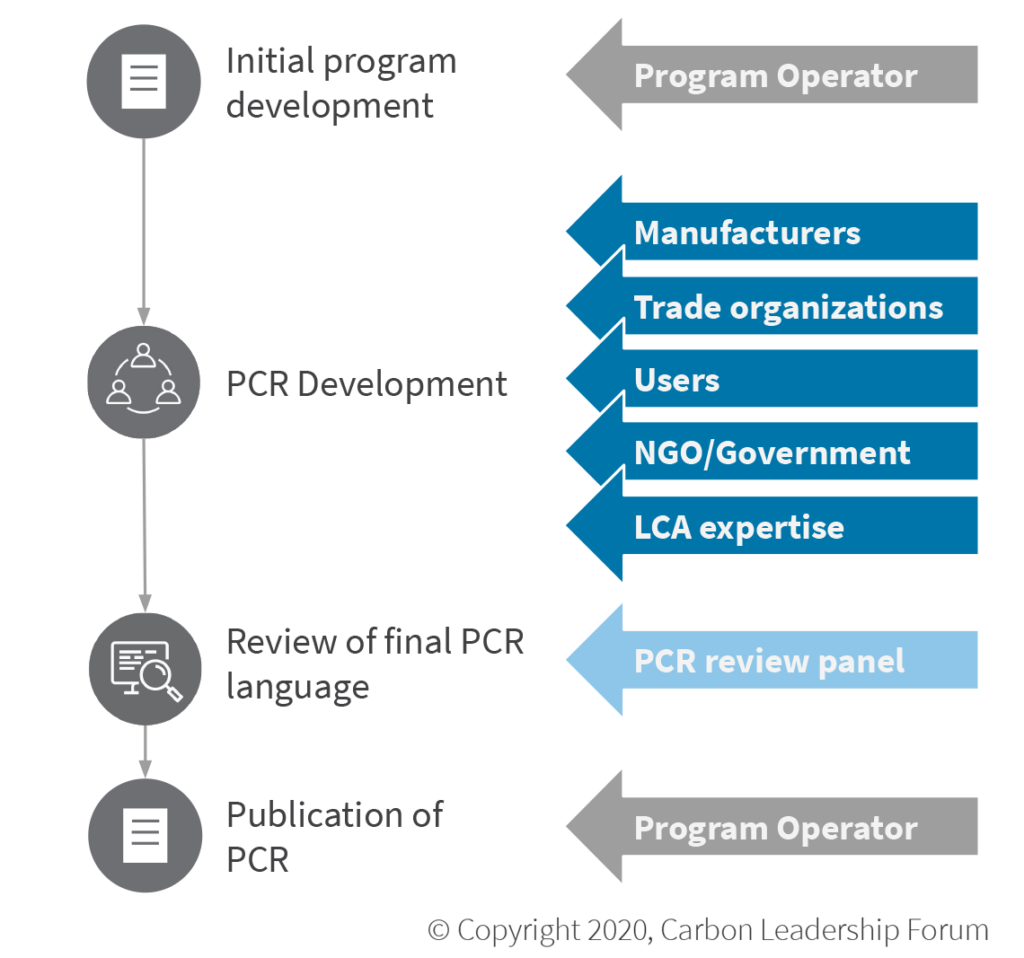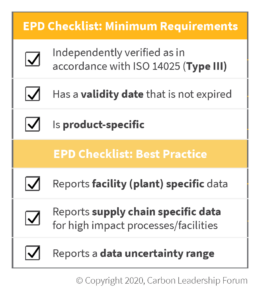This resource aims to guide policymakers and procurement professionals in collecting high-quality embodied carbon data. Policies targeting the reduction of carbon emissions associated with building products require the disclosure of embodied carbon data to inform policies and verify whether reduction targets or incentive requirements have been met.
Environmental product declarations (EPDs) are independently-verified documents based on international standards that report the environmental impacts of a product. These declarations can be used to track supply chain-specific product data and compare products if the products are functionally equivalent and have aligned scopes.
Calculating embodied carbon requires an LCA
To understand the embodied carbon or supply chain carbon emissions of a product, you need a life cycle assessment (LCA) of the product. LCA is a method for quantifying the environmental impacts of a product throughout its life cycle that can be applied to any product. The primary stages include:
- Product (A1-A3), which includes extraction and upstream processing of materials, transportation, and manufacturing impacts
- Construction (A4-A5), which includes transport to the site
- Use (B), which includes maintenance and replacement
- End-of-life (C), which including demolition and disassembly as well as waste processing and transportation
- Beyond the life cycle (D), which includes potential benefits from reuse, recycling, and/or energy recovery
Greenhouse gas emissions, including carbon dioxide, are added up over the product’s life cycle and reported as global warming potential (GWP). GWP is expressed in carbon dioxide equivalents (CO2e), and is an agreed-upon definition for expressing a product’s carbon footprint.
Environmental Product Declarations (EPDs) are the right tool for disclosure and transparency
To be effective, an agreed-upon methodology for measuring and calculating the embodied carbon of products must be used consistently. In the building industry, EPDs are this agreed-upon tool and methodology.
An EPD is a “nutrition label” for a product’s environmental footprint. Just like with a food nutrition label, you need to know what you are looking for to know whether a product is healthy: looking at an EPD on its own won’t tell you whether or not a product is good for the environment.
EPDs provide environmental data based on a life cycle assessment (LCA) that was independently verified in accordance with ISO 14040 and ISO 14044. EPDs may report a variety of life cycle impacts in addition to global warming potential (GWP), such as acidification, eutrophication, ozone depletion, and smog formation. EPDs also typically include additional manufacturer and product data, such as ingredients, manufacturing processes and locations, and resource use.

Figure 1. Flow of data from the supply chain to an EPD and project submittal. (*) indicates areas where specificity and other minimum data requirements are set by the Product Category Rule. Policies can add requirements to strengthen data reporting.
Ingredients of an EPD
Who decides what goes into an EPD?
A product category rule (PCR) defines the rules and requirements for developing Type III EPDs for a group of products that fulfill an equivalent function and must be updated every 3-5 years (ISO 14025:2006). There are PCRs for a large number of building products, and the requirements in each PCR vary slightly.
Similar to other industry standards, the development of PCRs is an open stakeholder development process. This means that interested stakeholders, including industry and trade associations, review the draft PCR and provide feedback throughout its development.

Figure 2. Process and stakeholders for PCR development (adapted from process outlined by ISO 14025:2006).
The development of a product category rule is led by a program operator. A program operator is a company, industry sector or trade association, public agency, or independent body that manages the development and publication of a PCR and resulting EPDs. Examples of North American program operators include ASTM, NSF, UL Environment, SCS Global Services, and Sustainable Minds.
A PCR includes critical requirements that define what data is included in the LCA calculations, such as:
- Which life cycle stages must be included (system boundary)? See Figure 3 for typical variation in EPDs.
- Which impact categories must be reported in addition to global warming potential?
- Which data need to be supply chain specific, and which can be generic (i.e. industry-wide)?
- Which facilities need to contribute data to the life cycle assessment?
Opportunities for data quality and alignment
EPDs are the best available tools for embodied carbon disclosure and transparency. However, they will improve over time as requirements for data quality are increased and the underlying standards and datasets that inform how EPDs are calculated are aligned.
It is important to weigh data and reporting requirements against the added time and administrative burden on manufacturers. For example, the data collected and analyzed for a product’s LCA may be made up of either (a) primary data from the actual facilities and processes in the product supply chain or (b) from generic or representative data from a database or similar source. The former is referred to as supply chain specific. Collecting supply chain specific data for 100% of processes is not feasible or necessary, but requiring supply chain specific data for the stages with the largest impact on emissions (80% or more) would increase the value of an EPD by making it more representative of the actual product.

Figure 3. Life cycle stages typically included in EPDs (module names are in accordance with ISO 21930). To understand which life cycle stages are required to be reported in an EPD, first look at the requirements in the PCR. Additional stages are included at the discretion of the manufacturer creating the EPD.
Guidance on Policy Requirements
Policies that require embodied carbon data transparency and disclosure should require valid, product-specific Type III environmental product declarations (EPDs). Requiring best practice reporting in addition to the minimum requirements can help guide future alignment and strengthening of the standards that guide EPD development.

A Type III EPD is one that has been independently verified to be in accordance with ISO 14025 – Type III environmental declarations – Principles and procedures.
EPDs are valid for five years from the date of issue. All EPDs state the date of issue and period of validity.
A product-specific EPD represents a product from a single manufacturer. An industry-wide average EPD is not a product-specific EPD.
An EPD with facility (plant)-specific data reports impacts calculated based on inputs collected from the actual facility (or facilities) where the product was manufactured.
Supply chain-specific data is based on inputs from the actual supply chain of a product, rather than generic or industry-wide data. EPDs should report the overall percent (%) supply chain-specific data. Ideally, EPDs should target to include supply chain-specific data for processes or facilities that comprise 80% or more of the cradle-to-gate impacts of a product.
Guidance on Using EPDs for Comparison
Comparisons between EPDs should only be made if (1) their impacts were calculated using the same methodologies and (2) the products being compared are functionally equivalent. The environmental performance of two different materials (e.g. concrete and wood) cannot be compared using EPDs.
Functionally equivalent products have the same unit (such as ‘one metric ton of steel’) and technical performance. Technical performance characteristics vary by product category and use. For example, performance characteristics of structural concrete include criteria like strength, cure time, and durability, whereas carpet criteria may include things like use (commercial vs. residential) and durability (density, etc.).
Note that functional equivalence is a process that involves judgment and assumptions, and must be done with care.
Once the functional equivalence of the products being compared is established, it is also key to ensure that the EPDs have the same:
- Methodology: EPDs should follow the same PCR.
- System boundaries: EPDs must include identical life cycle stages. Life cycle stage reporting varies (see Figure 3) and the reported stages must be the same (i.e. cradle-to-gate analysis cannot be compared to cradle-to-grave, etc.)
- Upstream data: Life cycle inventory datasets for transportation and electricity generation should be aligned.